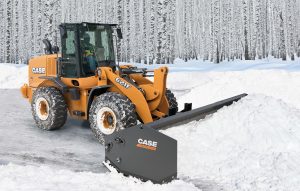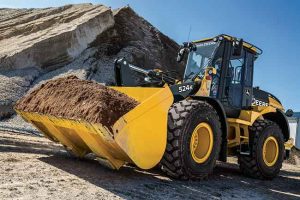
How to prep your wheel loaders for winter
By Nate Hendley
Construction Materials Equipment snow snow removal wheel loader wheel loaders winter If you want to use your wheel loaders in winter for removing snow or anything else, you need to ensure your machines can handle cold-weather conditions. An obvious way to protect your equipment in wintertime is to park it in a heated facility when not in use.
If you want to use your wheel loaders in winter for removing snow or anything else, you need to ensure your machines can handle cold-weather conditions. An obvious way to protect your equipment in wintertime is to park it in a heated facility when not in use.
“If you have the ability to keep [your wheel loader] inside a climate controlled environment, then the machine’s going to work better, it’s going to start up better, it’s going to get to operating temperature sooner,” says Brad Stemper, solutions marketing manager for CASE Construction Equipment.
Problem is, heated facilities are few and far between on construction or highway worksites.
“If you are not able to keep it inside, the recommendation is to at least plug it in. Doosan offers a block heater option if the wheel loader is kept outside,” says Michael Stark, product specialist, wheel loaders for Doosan Heavy Equipment and Doosan Infracore Construction.
Again, this step isn’t always practical so at the very least “park the wheel loader out of the wind. If there’s blowing wind, there will be wind chill and that makes it that much colder,” says Stark.
While keeping a wheel loader in a heated facility or plugged into a block heater is ideal, most wheel loaders today are “well-designed to operate in very cold temperatures,” notes Stemper.
In extreme conditions, “you can also pull the batteries. Batteries work better when they’re warmed up a little bit. Cold cranking amp batteries [are an idea],” says Stark.
 According to CASE information, fully charged batteries at 1.4 degrees Fahrenheit retain less than half of their normal starting power. Once the temperature reaches -20.2 degrees Farenheit, the battery has less than a fifth of its normal starting power. In very cold weather, CASE recommends running wheel loaders and other construction equipment long enough for batteries to regain any charge lost by starting.
According to CASE information, fully charged batteries at 1.4 degrees Fahrenheit retain less than half of their normal starting power. Once the temperature reaches -20.2 degrees Farenheit, the battery has less than a fifth of its normal starting power. In very cold weather, CASE recommends running wheel loaders and other construction equipment long enough for batteries to regain any charge lost by starting.
Running the machine at low throttle prior to a shift also gets warm hydraulic oil circulating.
“You want to warm up [the wheel loader] and warm up the hydraulic oil. Run the boom and the bucket,” says Stark.
The duration of the warm-up “depends on the temperature and wind chill. It could take 10 minutes. In extreme cold weather, I would highly recommend 10 to 15 minutes. The longer you warm it up, the better it is on the machine,” he continues.
Once you’ve let the wheel loader warm up “you want to slowly go through some cycles—rotate your bucket fully open, rotate your bucket fully closed. Do it slowly. Raise your lower arms all the way up, lower your lower arms all the way down,” advises Stemper.
Construction equipment experts were asked about anti-freeze, typically a 50/50 water/glycol mix.
“There are multiple grades of anti-freeze for use with wheel loaders. A 50 per cent grade will work to temperatures down to -40 degrees Farenheit. As you go above that, say every 20 degrees or so, you can start decreasing your anti-freeze. At -22 degrees Farenheit, you could probably get away with 45 per cent anti-freeze and 55 per cent water,” says Stark.
Stemper says OAT (Organic Acid Technology) coolant has proven to be effective in increasing engine protection and coolant performance and longevity. CASE began shipping select machines with OAT coolant in December 2013 and will expand the coolant across further product lines throughout 2016. (See OAT sidebar on pg. 30)
“OAT coolant doesn’t mix with the traditional coolant that you and I have always put into the car [in winter]. If you mix the two, it will actually gel,” Stemper warns.
Experts urge wheel loader operators to top up their fuel tank after every winter shift.
Doing so, however, tends to be “one of the most overlooked items” on an operator’s wintertime to-do list, says Chris Cline, product marketing manager for utility loaders in John Deere’s Construction & Forestry Division.
“Any time you have a day that’s warmer than night and you have that cold, you’re going to get condensation, which turns to water. Then you have water in the system, which can damage and destroy your engine,” states Cline.
Topping up the tank after every winter shift is “a good process to help reduce the condensation in the wheel loader’s fuel tank. Overall, it’s a good practice to follow year-round,” agrees Stark.
On the topic of tires, Stark says, “I would definitely keep L3 tires or something like that, or radial tires. L5, you don’t really need. I wouldn’t do anything smaller than L3 for good traction in snowy conditions. Radial tires will probably give you better traction than bias tires in winter. If you have a condition where you really need extra traction, you can put chains [on your tires temporarily]…Chains are hard on pavement, so just use them for extreme conditions.”
“An important maintenance tip in winter is keeping your wheel loader tires at their correct inflation…following the correct wheel loader tire inflation will help add life to the tire,” explains Stark.
Tires should also be inspected for damage prior to winter use. In a similar vein, it’s important to replace damaged glass and mirrors before using your wheel loader in winter and making sure work lights, beacons, flashers, signals, brake lights etc. are all in working order.
Some construction equipment companies sell “cold weather packages” for winter use.
“A cold weather package on a wheel loader can protect machines working in extreme temperatures down to -50 degrees Fahrenheit. One such package [from CASE] offers two heavy duty 950 CCA 12V batteries, low-temperature hydraulic oil, a hydraulic oil cooler bypass, hydraulic heat load valve, an engine block heater, an air-intake grid heater and fuel warmer, heated mirrors and a reversing fan to remove snow accumulation from the radiator,” says Stemper.
The human factor should not be overlooked when winterizing wheel loaders. Doors, panels and seals should be inspected before the advent of cold weather to make sure there are no leaks or cracks and wipers inspected to make sure they’re working properly. Many wheel loader cabs are heated while some even come with heated seats, all for the benefit of the operator.
If operators need to run through a warm up cycle, Stark recommends some cooling off time once work is done as well.
“Go through a cool down procedure [after your shift]. If you’re working hard, even in very cold weather, everything heats up. If you let it cool down for a few minutes, it benefits the engine life. A lot of people make this mistake and just jump out of the cab [after a shift],” states Stark.
Other tips: keep your wheel loader clean. Stemper says it’s particularly important to keep the undercarriage clean in winter. By failing to do so, slush and snow that accumulates during the day can turn into solid ice at night.
Keep windows clean too, to maintain visibility (an extremely important consideration in winter).
Snow removal
Most manufacturers offer attachments to turn wheel loaders into snow removers.
CASE recently introduced a new line of heavy- and light-duty sectional snow pushers, compatible with current and older wheel loaders. The heavy-duty line, for full-sized wheel loaders, includes pushers up to 17 feet wide. Each pusher has a Hardox 450 steel cutting edge, designed to scrape down to pavement.
As for Doosan, “we have a snow pusher attachment mounted to our Doosan bucket with chains. The snow pusher is designed for use with our smaller wheel loaders. There’s also the all-purpose bucket that can be used with a wheel loader to load snow into trucks or pile it high,” says Stark.
John Deere has general-purpose buckets for snow removal and works with aftermarket suppliers who can equip wheel loaders with attachments for the same purpose.
For snow removal or anything else, Cline offers the following summary for winterizing your wheel loader: “Keep your machine clean, monitor and maintain fluid levels, make sure you’re using the right type of fluid for the temperature, keep your joints greased and check tire pressure. Those are my big ones [for winter-use].”
Nate Hendley is a Toronto-based freelance writer and author. Send comments to editor@on-sitemag.com.




